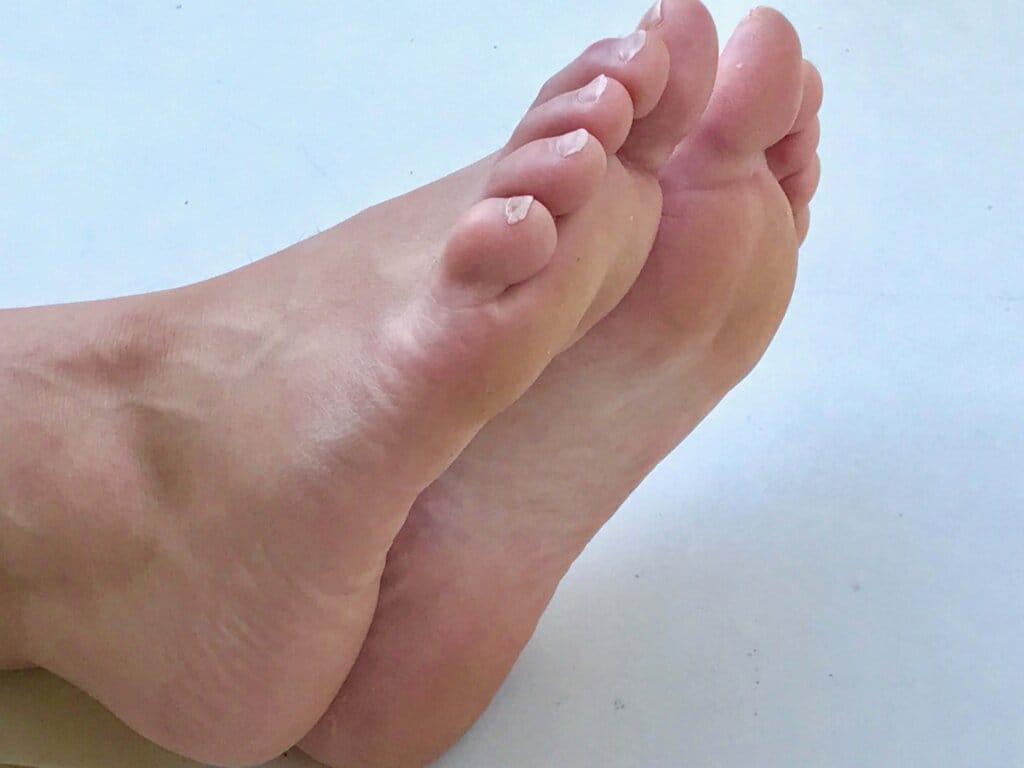
Dealing with persistent foot problems
Many of us at some point in our lives will encounter a problem with our feet. They are after all one of the most hardworking parts of our bodies! But some of us will end up with persistent foot problems that we find hard to shift. Here, we will cover just a few of them, alongside some hints and tips for treating and preventing them.
Corns
Corns are little patches of what is basically very hard skin, that form as a reaction to friction and pressure. They can occur anywhere on the feet, underneath, on the tops or ends of the toes, and even between the toes.
They can be easily treated in the short term by a Podiatrist. Treatment involves gently removing the hard skin from around the corn, then carefully removing the central plug of hard skin. However, as corns have pressure and friction as their cause, removing that pressure is the key to preventing the corns coming back. If you are struggling with recurrent corns at home, then here are some of our top tips –
- make a note of which shoes are causing you the most discomfort. Corns on the tops of the toes are always down to footwear, as shoes are the only things in contact with the tops of your toes.
- If your corns are on the soles of your feet, then soft, cushioned soled shoes will help, as these will reduce some if the shear forces on the skin and provide some cushioning. For corns between the toes, using a toe separator can sometimes help, as will wider fitting footwear.
- Please try to avoid using medicated corn plasters! These don’t address the underlying cause of the corn and will generally irritate the surrounding skin. If you do want to use a corn plaster, then please use a non-medicated corn ring, one that has a hole in the centre to offload the pressure from the corn. These plasters don’t contain the acids that the medicated ones do.
Verrucae
We’ve covered these may times before in our previous blogs, especially those on our Swift treatment. You can read more of those here.
Verrucae are caused by a viral infection, strains of the HPV virus to be precise. They are very common, and can be stubborn to treat, as an immune response from the body is needed to eradicate the virus. In some cases, over the counter treatments such as Bazooka do work, but persistence is required, and where possible it’s best to use the strongest concentration available. If you’ve tried everything at home to treat them, then seeking advice from a Podiatrist is advisable. Verrucae can hang around for years until they go away on their own and can be unsightly and painful before they do disappear. Our top tips –
- If you want to treat at home, then visit a pharmacy who can advise on the most suitable topical therapy – try to use the strongest you can and be persistent! It can take a while to treat.
- To prevent picking up verrucae, try to avoid going barefoot in public places. Where possible, wear flip-flops or similar in places like changing rooms and around swimming pools.
Athlete’s foot
Athlete’s foot is basically a fungal infection in the skin. There are certain strains of fungus that are specially adapted to live on the skin, and our feet can give them the perfect environment to thrive. Fungi prefer warm, dark, damp environments, so our feet inside socks and shoes are perfect!
Many people may not realise they have a fungal infection in their feet. Thes infections can, but don’t always itch. If you have persistent dry skin, often with a slight red “halo” around it, then this can be a low-grade form of athlete’s foot. For some people, these infections can be tough to eradicate. Our top tips –
- The trick with athlete’s foot, is that you can’t just treat the skin alone. Anything that has been in contact with the skin on the feet (socks, shoes, tights, towels, bathmats, bedding, trousers etc) also need to be treated. It’s always worth popping some Dettol laundry disinfectant in with each wash to help keep any fungal burden to a minimum - washing at 30-40 degrees is not hot enough to kill fungal spores.
- As mentioned, footwear also needs to be treated. There are several products out there for this purpose, such as Daktarin powder spray.
- For treating the skin itself, a terbinafine based cream daily for a couple of weeks should get any infection under control. Terbinafine is a good medication to use as it is fungicidal. See a pharmacist who can advise on what is suitable for you.
If you have any concerns about athlete’s foot, how to manage it or if you would like a definitive diagnosis, then seek treatment from a Podiatrist.
Fungal nail infections
These are one of the hardest things to treat. It’s always best if you think you may have a fungal nail infection to seek advice from a Podiatrist as soon as possible, as the more widespread the infection becomes, the harder it is to treat. Our tips? -
- There are lots of topical treatments out there which claim to cure fungal nail infections, some more effective than others. The truth is, the thicker the nail, the less effective these treatments can be. For any topical treatment to work, ideally the nail needs to be as thin as possible to allow any ingredients to penetrate fully. It’s best to seek advice and treatment from a Podiatrist who can reduce the bulk of the nails and advise on the best topical therapy for you.
- In some cases, oral medication from the GP will be the best option, if the infection has spread beneath the cuticle of the nail. Above all else, as with many of these stubborn foot problems, persistence is key. For treating a fungal nail infection, it can take many months, as the nail needs to have grown completely clear before treatment is stopped.
- Ideally the skin also needs to be treated for athlete’s foot at the same time to prevent reinfection of the nails.
We hope some of this information has been helpful to you. Remember – if you would like help treating persistent foot problems, you can book in to see us here.
Anna Conway
BSc (Hons), MCPod, SRCh, PGcert Podiatry
Owner, Lead Podiatrist

